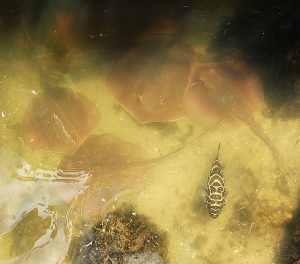Day two of the Pelican Harbor fish kill & stranding event, day four of the fish kills throughout Biscayne Bay. At this point, more than 30 locations have reported sightings of fish kills, from Key Biscayne at the furthest south to about 96th street in the northern part of the County, and as far east as North Miami Beach. Miami Waterkeeper has an updated map with the locations on their web site. More than two dozen species of fish and invertebrates have been documented in the mortality events including crabs, shrimp, flounder, mangrove snapper, snook, angelfish, parrotfish, eels, trunkfish, and others.
At the Pelican Harbor Seabird Station, things seemed to have improved a little today. As an intervention strategy, the Frost Science Museum employed aerators and oxygen supply to create slightly higher oxygen levels in this shallow area in the small basin on the north side of the Station. Measurements collected showed 7% dissolved oxygen at depth, 32% at the surface. These levels are dangerously low. 80% dissolved oxygen or higher is the desired target for a health water body.
Based upon my observations, there were far less bony fish stranded as compared to yesterday. The Atlantic Stingrays were still present, but in smaller numbers. There was discussion about re-locating the stingrays further offshore, but that wasn’t favored because it can be extremely stressful to the animals. While aerators and oxygen infusion is not a long-term solution, it’s possible that it’s buying time for these fish to find higher-oxygen areas, or allow for photosynthesis to help produce more oxygen.

While it’s still too early to determine the exact cause of the low dissolved oxygen event, it is clear that there is cause for concern. At this point, hundreds, if not thousands, of fish have died since Monday, and we (the scientific, management, and educational communities) do not know if the end is in sight. This is a sign that this ecosystem is under stress from many sides. Biscayne Bay is the jewel of Miami, and contributes to our economy. Recreational and commercial fishing are dependent upon the nursery habitat that the Bay provides, real estate and businesses rely upon the beautiful views that the Bay offers.
Partners in the coordination and response efforts include Miami Waterkeeper, FDEP Biscayne Bay Aquatic Preserves, FIU Shark and Ray Team, Frost Science Museum, Miami-Dade County Environmental Resource Management, National Oceanic Atmospheric Administration, the Pelican Harbor Seabird Station, the University of Florida/IFAS Extension & Florida Sea Grant.
If you see either fish kills or large fish congregations near the surface, please capture photos and GPS coordinates (if possible) and report to: hello@miamiwaterkeeper.org.
 0
0
